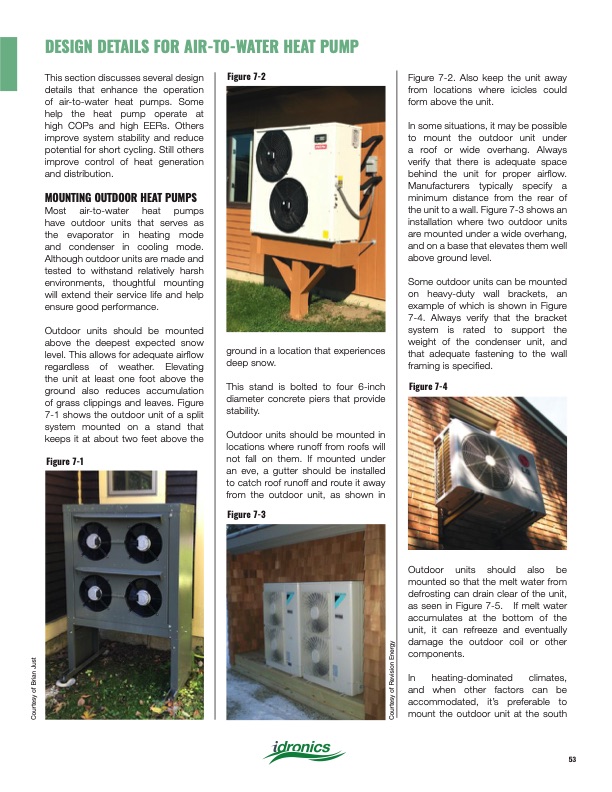
PDF Publication Title:
Text from PDF Page: 053
DESIGN DETAILS FOR AIR-TO-WATER HEAT PUMP This section discusses several design details that enhance the operation of air-to-water heat pumps. Some help the heat pump operate at high COPs and high EERs. Others improve system stability and reduce potential for short cycling. Still others improve control of heat generation and distribution. MOUNTING OUTDOOR HEAT PUMPS Most air-to-water heat pumps have outdoor units that serves as the evaporator in heating mode and condenser in cooling mode. Although outdoor units are made and tested to withstand relatively harsh environments, thoughtful mounting will extend their service life and help ensure good performance. Outdoor units should be mounted above the deepest expected snow level. This allows for adequate airflow regardless of weather. Elevating the unit at least one foot above the ground also reduces accumulation of grass clippings and leaves. Figure 7-1 shows the outdoor unit of a split system mounted on a stand that keeps it at about two feet above the Figure 7-2 ground in a location that experiences deep snow. This stand is bolted to four 6-inch diameter concrete piers that provide stability. Outdoor units should be mounted in locations where runoff from roofs will not fall on them. If mounted under an eve, a gutter should be installed to catch roof runoff and route it away from the outdoor unit, as shown in Figure 7-3 Figure 7-2. Also keep the unit away from locations where icicles could form above the unit. In some situations, it may be possible to mount the outdoor unit under a roof or wide overhang. Always verify that there is adequate space behind the unit for proper airflow. Manufacturers typically specify a minimum distance from the rear of the unit to a wall. Figure 7-3 shows an installation where two outdoor units are mounted under a wide overhang, and on a base that elevates them well above ground level. Some outdoor units can be mounted on heavy-duty wall brackets, an example of which is shown in Figure 7-4. Always verify that the bracket system is rated to support the weight of the condenser unit, and that adequate fastening to the wall framing is specified. Figure 7-4 Outdoor units should also be mounted so that the melt water from defrosting can drain clear of the unit, as seen in Figure 7-5. If melt water accumulates at the bottom of the unit, it can refreeze and eventually damage the outdoor coil or other components. In heating-dominated climates, and when other factors can be accommodated, it’s preferable to mount the outdoor unit at the south Figure 7-1 Courtesy of Brian Just Courtesy of Revision Energy 53PDF Image | Heat Pump Systems 2020

PDF Search Title:
Heat Pump Systems 2020Original File Name Searched:
idronics_27_na.pdfDIY PDF Search: Google It | Yahoo | Bing
CO2 Organic Rankine Cycle Experimenter Platform The supercritical CO2 phase change system is both a heat pump and organic rankine cycle which can be used for those purposes and as a supercritical extractor for advanced subcritical and supercritical extraction technology. Uses include producing nanoparticles, precious metal CO2 extraction, lithium battery recycling, and other applications... More Info
Heat Pumps CO2 ORC Heat Pump System Platform More Info
| CONTACT TEL: 608-238-6001 Email: greg@infinityturbine.com | RSS | AMP |